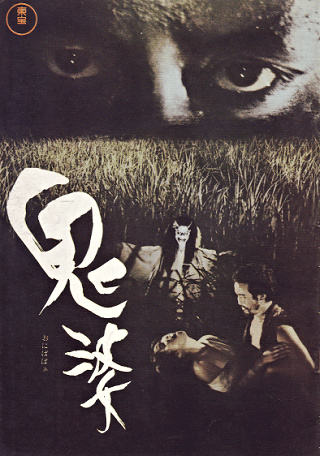Kaneto Shindo’s Onibaba (1964) is striking in that its darkness only serves to enhance its sublime beauty.
Rendered in black-and-white, amidst swaying fields of susuki (tall pampas grass) in Japan’s Chiba prefecture, the lonely and vast landscape is an arresting backdrop to what is essentially a story about the “sexual desire of the soul”, as Shindo described it himself.

Set during the mid-16th century, a time period known as the ‘Warring States period’, an era of civil war, it features an old woman played by Noboku Otawa as well as her daughter-in-law (Jitsuko Yoshimura), both of whom are struggling to survive. They end up killing stray soldiers under cover ofthe tall grass, exchanging their armour and valuables for food.
One day, a young man named Hachi returns from the war, telling them that their son/husband has died – he later becomes sexually involved with the young widow, something the old woman starts to view equally both with fear and resentment. In order to stop the relationship, she begins to dress as an oni, or demon, to scare her daughter-in-law, a course of action that ultimately dooms her.
Inspired by a Buddhist fable, the original story had the old woman dress up as a demon in order to prevent her daughter-in-law from going to the temple, resulting in her being temporally unable to remove the demon mask from her face till, through Buddha’s mercy, she manages to do it-only to find her face horribly scarred.
Shindo transforms the plot by setting it in a time of moral anarchy, where man is driven by base desires.
Death and hell, represented by the dark pit in which the women toss their dead are omnipresent but it is the idea of hell on earth that permeates every minute of the movie. More than that, it is the darkness within us, “one that has existed from ancient times onwards” as the opening lines to the film say, which are dealt with extensively.
The storyline in itself is not overtly remarkable – its main issues, jealousy, desire, violence as well as the struggle for control are pretty mundane – however, the way the movie is shot is what evokes what is essentially a heady, seductive atmosphere, both ripe and rank with destruction. This effect is achieved via extreme close-ups of the blades of grass, whose swaying becomes progressively ominous as the shadows between them become more and more prominent.
Also, during the course of the movie, the sensuality of the movement of the susuki becomes a symbol of the young lover’s passion. This was expressly intended by Shindo, whose then bold shots featuring the upper thighs as well as the bare breasts of his female actors were viewed as pornographic by contemporary Japanese cinema, causing him to release the movie via his own production company.
Nonetheless, it was one of the first Japanese films to win international acclaim – though it was only in 1994 that the uncensored version became available in the UK.
The interplay of light and shadow is masterfully handled, with figures emerging and looming in the darkness or moving from light to dark in rapid succession. Yet, it is the subversion of the colour white that is truly memorable. Be it the blindingly menacing sunlight on the long reeds of grass or the glittering sheet of water connecting a dark horizon with an even darker shore – both seem to be the embodiment of Melville’s diatribe against the terror of whiteness, to be found in his acclaimed novel, Moby Dick.
In many ways, Onibaba reminds me of the Seventh Seal (1957), Bergman’s classic masterpiece – a film similarly set in medieval times, during the upheaval caused by the Plague. The personification of Death in that film is similar to that of the demon represented by the mask- with both films beginning and ending with death.
Its unpretentious simplicity makes it a refreshing watch. Despite being slow-paced at points, this gothic horror film reminds one of a luridly enchanting, Kafkaesque nightmare- a nightmare that threatens to be real…
